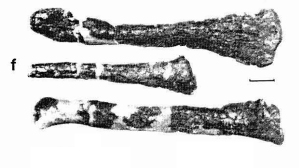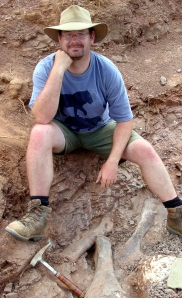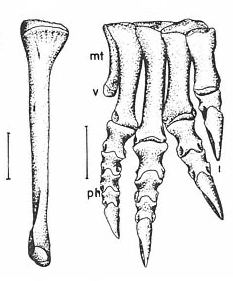The Largest ‘Prosauropods’. Part 1: The megaplateosaur that wasn’t
Recently I’ve been looking into the size of basal sauropodomorphs. Some of these guys reached really impressive sizes, and it wasn’t just the so-called melanorosaurids. Indeed two of the top three on my list are probably going to be a surprise to some.
But before we get to the list I have to deal with a non-starter in the competition for title of ‘largest prosauropod’
Pachysaurus? giganteus: the megaplateosaur that never was.
Don’t be surprised if you haven’t heard of this guy. There is precious little written about it and precious little of it in the first place. The species was first coined by Friedrich von Huene (1932), the doyen of European plateosaur studies, for a cluster of long bones that he took to be part of an articulated metatarsus (the part of the foot that fits between the toes and the ankle). He tentatively placed it in the now defunct genus Pachysaurus (a synonym of Plateosaurus). They were found in the Trossingen Plateosaurus quarry, well known for its abundance of articulated Plateosaurus fossils including articulated skeletons as well as many dispersed isolated bones. The longest of these supposed metatarsals was a massive 52 cm long. To put that into some kind of perspective: the longest metatarsal of the larger individual of Aardonyx (itself a big basal sauropodomorph) is less than half as long. Indeed we can extrapolate from this a range of femur lengths for P. giganteus from 1.5 to 2 meters (depending on wether we give it a stumpy Aardonyx-like foot or a more elongate Plateosaurus-like foot). The upper end of that range is nosing into brachiosaur size territory. As appealing as the notion of Brachiosaurus-sized plateosaurs cruising around the Late Triassic might be, I’m afraid that it almost certainly wasn’t so. The specimens were re-examined by David Weishampel who found that they were not metatarsals at all, rather a cluster of three fibulae (Weishampel, vide Galton, 2001). Presumably they would have been brought together by current action, long after their respective carcasses had decayed and their skeletons dispersed. Such current sorting is not unusual. Here is a picture of me next to a little minicluster of tibiae in one of our Spion Kop quarries (no they are not Aardonyx bones).
Now of course this kind of reassessment of bone ID makes me a little uncomfortable. Von Huene was no fool and to suppose that he mistook fibulae for metatarsals does strain credibility a little. On the other hand Weishampel is no fool either and the preservation of the P. giganteus bones is truly awful, obscuring their true identity. See for yourself.

The original bones of 'Pachysaurus? giganteus'. Scale bar equals 5 cm. Image from Galton (2001, fig. 10).
Admittedly the figure from the paper is not the best (anyone who has photos, or access to the collections in Tubingen want to send some images in?) but it should be immediately apparent that they are way slender for metatarsals, especially metatarsals that exceed half a meter in length. First compare them to known metatarsals of Plateosaurus (on the right) and a fibula of Plateosaurus (on the left).
Not only do the bones of P. giganteus fit the size of an ordinary Plateosaurus fibula, the shape seems to match well.
References
HUENE, F. v. (1932) – Die fossile Reptil-Ordnung Saurischia, ihre Entwicklung und Geschichte. Monogr Geol. Palaeont., (1) 4: 1-361.
GALTON, P. M. 1990 – Basal Sauropodomorpha–Prosauropoda. 320–344. In WEISHAMPEL, D. B., DODSON, P. and OSMÓLSKA, H. (eds). The Dinosauria. University of California Press, Berkeley, 733 pp.
GALTON, P. M. 2001 – The prosauropod dinosaur Plateosaurus MEYER, 1837 (Saurischia: Sauropodomorpha; Upper Triassic). II. Notes on the referred species. Revue de Paléobiologie, Genève, 20: 435–502.


Adam,
I can have my Tübingen friends take pics and mail them, no sweat. I’ll give them a call on Monday.
That aside, I seem to remember these bones, which IIRC do not look like MTs at all.
We have a monster leg in Berlin, too, which is labelled Plateosaurus – but even Jaekel (1914), who published a figure of it, said it isn’t P. That one is high on my list of things-to-look-at, but I guess aside from size it is going to be non-diagnostic 😦
What do you mean by a “monster” log, Heinrich? Give me numbers!
off the top of my head:
the foot is 1.3 times as wide for the same length as in Plateoaurus, the toes much shorter. The femur (if it belongs) is about 1 meter long. Overall, the leg is way more robust than Plateosaurus. See Jaekel (1913-1914, p. 193, fig. 21).
Jaekel says: “Of the largest of the dinosaurs found here (No. XVIII), the femur of which is ca. 1 m long, I have shown the left hind foot in Fig. 21. It differs noticeably strong from the plateosaurids and likely belongs to a quite different family-group. Its metatarsalia are thickened much at the proximal ends, as is shown by the proximal view of the articulation surfaces shown below it [in Fig. 21]. The free phalanges are shorter and wider, especially the claws are short and conical. This is no longer a grasping foot, as was the case still in plateosaurids, but a walking and jumping foot, which normally was half erect, i.e., semiplantigrade.”
remarks in square parentheses by me.
Jaekel, O. 1913-1914. Über die Wirbeltierfunde in der oberen Trias von Halberstadt. Paläontologische Zeitschrift, 1:155-215.
ONE meter? Pffft.
🙂
You realize that for P. engelhardti this is actually right up at the highest limit? And that those finds may well not even BE Plateosaurus? GPIT/RS/7288 has ~60 cm(!) femora, 85 cm is a huge individual…..
So this animal was very long limbs, and probably a proportionally larger body – we’re easily talking about an animal here that weighed some 1.2 to 1.5 tons. For a “prosauropod”that’s big 🙂
Very interesting. I’m looking forward to the rest of this series.